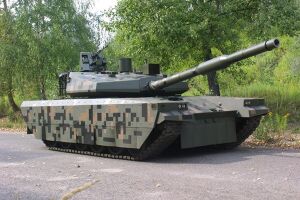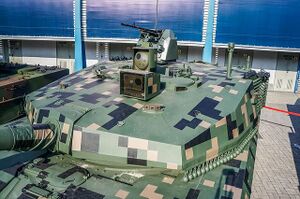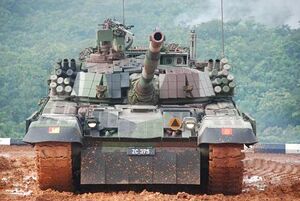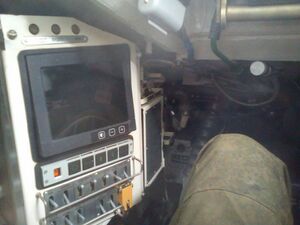PFC-88
| PFC-88 | |
|---|---|
 A pre-production PFC-88 used for mobility trials. | |
| Place of origin | |
| Service history | |
| Used by | |
| Production history | |
| Designer | GBPO |
| Designed | 2001-2014 |
| Manufacturer | PFC |
| Produced | 2017-present |
| Specifications | |
| Weight | 48.0 tonnes (52.9 short tons; 47.2 long tons) |
| Length | 9.67 metres (31 ft 9 in) gun forward 6.86 metres (22 ft 6 in) hull |
| Width | 3.7 metres (12 ft 2 in) with applique skirts 3.34 metres (10 ft 11 in) hull |
| Height | 2.61 metres (8 ft 7 in) |
| Crew | 3 (commander, gunner, driver) |
| Armor | Composite and reactive armor |
Main armament | 1 x Ostrołęka Zbrojownia A12/08 120mm L/50 cannon |
Secondary armament | 1x KZB UKM-2000 7.62mm Coaxial Gun 1x FFLS Sentinel RWS |
| Engine | SV12T V12 turbodiesel engine 1000 hp |
| Power/weight | 20.8 hp/tonne |
| Suspension | torsion bar |
Operational range | 500 km (310 mi) |
| Speed | 62 km/h (39 mph) |
The PFC-88 (Pińczów Fabryka Ciągników Model 88) is a modern Main Battle Tank designed by the Centralne Imperium Omandii’s GBPO (Grupa Badawcza Pojazdów Opancerzonych - Armored Vehicle Research Group) and manufactured by the PFC (Pińczów Fabryka Ciągników - Pińczów Tractor Factory). It is a development of the PFC-75, itself a development of the OSSR T-52. Extensive modifications have been made to the vehicle, most prominently a new turret and cannon. Almost all components of the tank are produced domestically, in contrast with the PFC-75 which made extensive use of Notreceauen sensors and fire control systems.
Design
Armament
The primary armament of the PFC-88 is the Ostrołęka Zbrojownia A12/08 120mm smoothbore cannon. The A12/08 was developed in 2008 to replace the myriad of inherited soviet systems with a modern cannon that is compliant with Allied standardization for future Omandii armored vehicle projects. It is constructed out of a reduced cost high strength steel superalloy, which allows the cannon to withstand the high pressure of modern kinetic energy anti-tank munitions in a more compact and lightweight system. Compared to the Notreceauen GIST-CN120-52/2 and the Lumenic CPCA-120/95 120mm cannons, which have a weight in excess of 3500 kilograms, the A12/08 weighs approximately 3200 kilograms.
The PFC-88 mounts the A12/08 cannon to a bustle-type autoloader. This new autoloader is contained entirely within the turret, in contrast to the carousel type autoloader used in the PFC-75 and T-52 which was partially recessed beneath the turret ring and into the hull. Compared to the OSSR derived 125mm gun used on the PFC-88’s precursors, which used two piece ammunition, the A12/08 uses unitary ammunition. As a result, the reloading process requires fewer steps and can be completed more quickly. Where the PFC-75 and T-52 could maintain a rate of fire of 7 rounds per minute, the PFC-88 is capable of a sustained 12 rounds per minute. The autoloader is also capable of unloading the gun while it is loaded, a process that takes between 6 to 8 seconds. The bustle autoloader contains 20 rounds ready to fire, with another 16 rounds in a hull magazine.
Three types of ammunition were developed for use with the A12/08: a high-performance tungsten APFSDS round for defeating heavily armored AFVs, a multipurpose HEDP round which is capable against a wide variety of soft targets and structures, and the “Oszczep” long range laser-guided gun launched tandem-warhead anti-tank guided missile, effective against ground vehicles and low flying aircraft at ranges of up to 5000 meters. It is also capable of firing the full range of Notreceauen, Lumenic, and Licanan 120mm ammunition.
Secondary armament comes in the form of a coaxial KZB (Końskie Zakład Broni - Konskie Weapons Factory) UKM-2000 general purpose machine gun. It carries a box of 2000 rounds of ammunition ready to fire. Additionally, the commander has access to a Trinovantan FFLS Sentinel remote weapon system, which usually mounts a 12.7mm WKM-B heavy machine gun but can be configured for a variety of weapons.
Protection
As the chassis of the PFC-88 ultimately has little difference from that of the OSSR T-52M1, the vehicle is inherently limited in terms of maximum weight and thus passive protection. The original T-52M1 vehicle was a mere 41 tonnes when equipped for combat, and the PFC-75 derivative which increased the weight of the vehicle to 46 tonnes had begun to approach the limits of the original chassis. While modernization of the T-52M1’s drivetrain and suspension components could reduce the effect of this increased weight, it still remained a stringent concern during the development of the PFC-88, with the vehicle being mandated to not exceed 50 tonnes of weight under any circumstance. As such, any gains in protection would have to come with minimal increases in weight.
Some of the largest gains in protection compared to the original T-52M1 and the derived PFC-75 come from the PFC-88’s new turret. The newly designed turret was constructed with a modern ceramic composite armor array incorporating modern high strength steel alloys, boron carbide, and limited amounts of tungsten. The resultant turret was sufficient to protect against all tested types of ammunition from guns of a caliber of up to 120/125mm, as well as modern ATGMs. The small frontal surface area of the turret, combined with the lighter and more compact bustle autoloader, resulted in only a modest increase in weight compared to the large gains in protection.
The vehicle’s hull would be a significantly more limiting factor. The turret saw such extensive gains by entirely replacing the obsolete turret with a design that used more modern materials and design considerations. This would not be possible with the underlying hull, which would remain the same as per the original T-52M1 vehicle. Any gains in passive protection to the hull would have to come from additional bolt-on armor either in the form of explosive reactive armor bricks, as per the PFC-75, or composite applique armor.
To this end, a metal-ceramic composite armor layer was developed that could be bolted into the hull of T-52M1 and derived vehicles using the existing ERA mounting points. This composite applique notably increased the passive protection of the frontal hull against chemical energy ordinance with some additional moderate protection against kinetic energy penetrators. However, due to the weight requirements the overall thickness of this applique armor was limited and the highly inclined hull of the T-52M1 could cause large sections of the applique to become damaged when impacted and perforated by incoming munitions.
As per the PFC-75, the PFC-88 can make use of PKERA compact explosive reactive armor. PKERA makes use of bricks that are smaller than most comparable ERA protective systems, using 150x150mm tiles. The explosive filling is relatively insensitive hexogen and the casing is thicker than other contemporary systems for the amount of explosive used. The small size, uniform shaping, and thick casing allows PKERA tiles to be mounted in very tight arrangements with little space between them. This increases the overall protected area of the vehicles they are mounted to. The PFC-88 can mount both single-layer PKERA-1 or the improved double-layer PKERA-2 to the hull in place of the composite applique armor. PKERA-2 would provide superior initial protection while the composite applique would provide more robust multi-hit protection against chemical energy and lower powered kinetic energy ammunition.
Other minor improvements were the addition of a rubber pad to the lower parts of the front hull, and a thick rubber skirt to protect the tracks. Protection from fires is achieved via an automatic halogen fire suppression system.
Mobility
As the earlier PFC-75 demonstrated, the T-52M1’s drivetrain struggled with additional weight. While measures were being taken to mitigate the increase of weight between the PFC-88 and the PFC-75, it was inevitable that the PFC-88 would end up even heavier than the PFC-75. As such, new systems were to be developed that would reduce the impact of this increase in weight. To this end, a new engine was developed to replace the original 740 hp SV46 diesel engine. The result of this was the SV12T 1000 hp turbodiesel engine. The SV12T, in addition to being more powerful, was also lighter and more compact than the original OSSR V46 engine and its SV46 locally produced copy. The new engine also came with a new, higher efficiency automatic transmission. The transmission comes with 6 forward gears and 4 reverse gears.
The new drivetrain components resulted in a power to weight ratio of 20 hp/t, not only higher than the PFC-75’s 16 hp/t but also higher than the original T-52M1’s power to weight ratio of 18 hp/t. The PFC-88’s final weight of 48 tonnes was considered to be within the scope of what the original T-52M1 suspension could tolerate, with each vehicle upgraded to PFC-88 standard getting a full inspection and either replacement or refurbishing of worn suspension components.
Sensors and Systems
One of the major concerns during the development of the PFC-88 was the use of Notreceauen sensors and fire control systems. While reliable allies during the Omandan continental war, it could not be guaranteed that such systems would continue to be available to the Central Imperium in the future. As such, it was made a priority to replace these systems with domestic equivalents during the PFC-88’s development.
The GBPO, with assistance from the Instytut Badawczy Czerwieńsk, developed a modern all-digital fire control system for the PFC-88 to replace the foreign digital-analog systems used in the PFC-75. This system analyzes information from the vehicle’s optical systems, the gun’s muzzle reference and crosswind sensors, the laser rangefinder, the multi-axis stabilizer, and loaded round data to quickly generate accurate firing solutions. Under testing, the system has achieved a first round hit probability of over 95% against stationary targets and a probability of over 70% in situations in which both the vehicle and the target are in motion.
Both the gunner and commander optics were similarly replaced. The gunner receives a semi-fixed 1-30x optic that has both image intensification and thermal imaging capabilities. The commander of the vehicle has access to an independently rotating wide-angle digital optic that has a 1-12x zoom, third generation high resolution night vision and thermal imaging. The commander’s independent optics allows for effective search and identification from within the vehicle, even in reduced visibility conditions. If the remote weapon system is present it can be used as a secondary search optic for the commander in the event that independent optic turret is destroyed or disabled, though it is less capable than the dedicated optic. Also present is a series of conventional periscopes to act as a backup in case of failure of commander's digital optics. The gunner similarly has a fixed periscope locked to the orientation of the gun. The driver is provided with a forward facing wide-angle optic with image intensification for driving under low light conditions.
Also present is a laser warning receiver, which notifies the crew if the vehicle is being painted by a targeting laser. This system provides the approximate bearing and elevation of the offending laser to the crew. In addition, the system is connected to the smoke dispersal system mounted on the turret and can be configured to orient the turret towards the potential threat and/or deploy obscurant countermeasures as an automatic response to laser detection. The laser warning system has 360 degree coverage of the vehicle.



